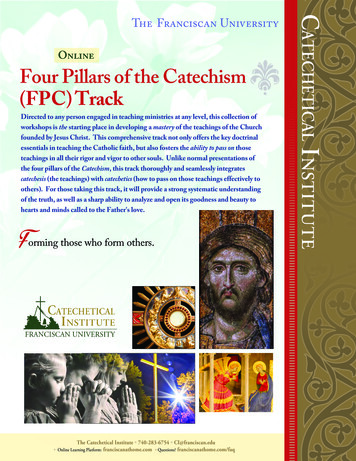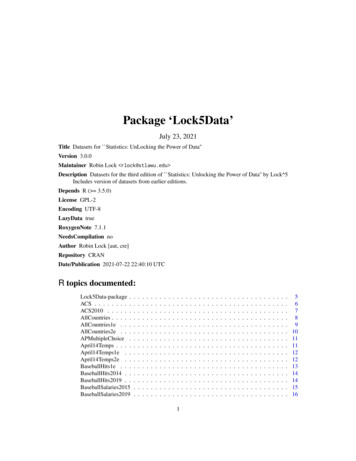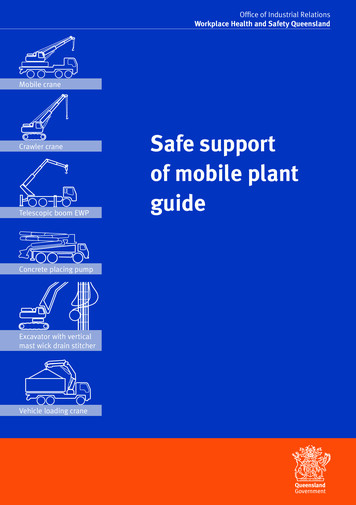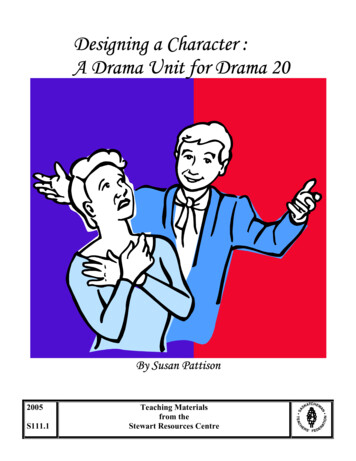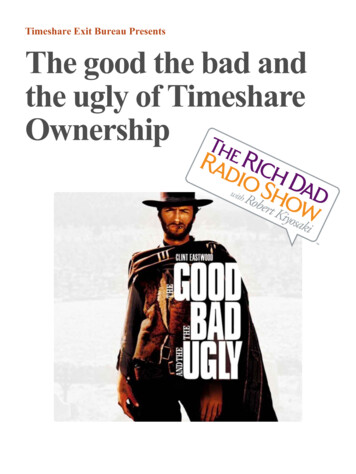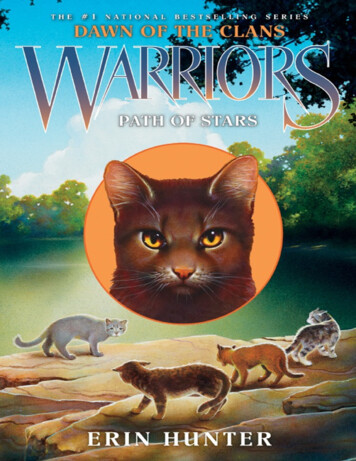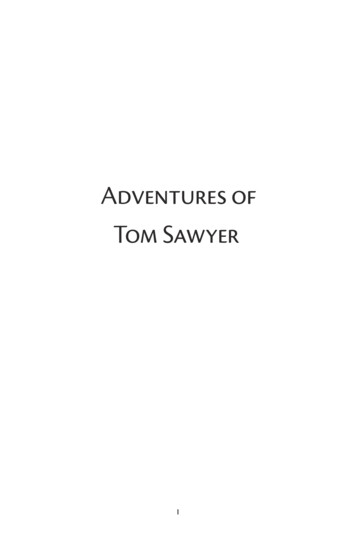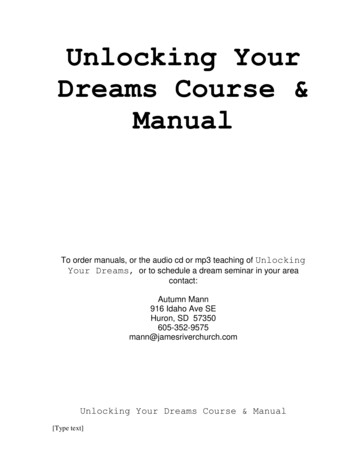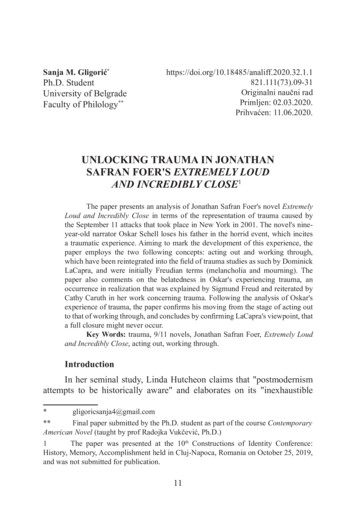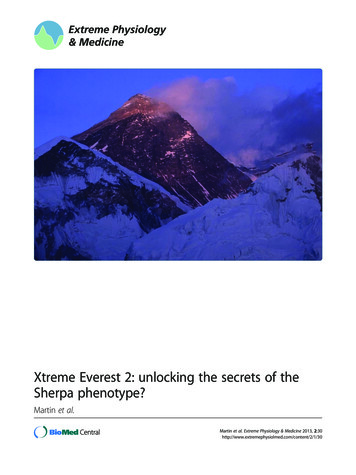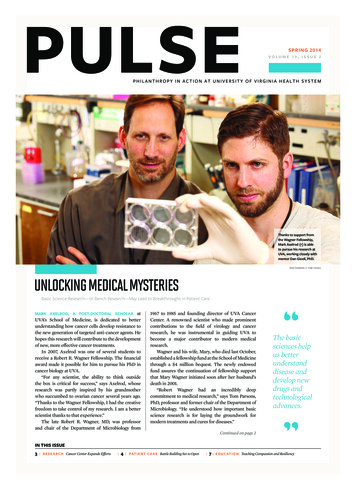
Transcription
Spring 2014v ol u me 1 9 , i s s u e 2Thanks to support fromthe Wagner Fellowship,Mark Axelrod (r) is ableto pursue his research atUVA, working closely withmentor Dan Gioeli, PhD.Photogra ph Tom cogillUnlocking Medical MysteriesBasic Science Research—or Bench Research—May Lead to Breakthroughs in Patient CareMARK AXELROD, a post-doctoral scholar atUVA’s School of Medicine, is dedicated to betterunderstanding how cancer cells develop resistance tothe new generation of targeted anti-cancer agents. Hehopes this research will contribute to the developmentof new, more effective cancer treatments.In 2007, Axelrod was one of several students toreceive a Robert R. Wagner Fellowship. The financialaward made it possible for him to pursue his PhD incancer biology at UVA.“For any scientist, the ability to think outsidethe box is critical for success,” says Axelrod, whoseresearch was partly inspired by his grandmotherwho succumbed to ovarian cancer several years ago.“Thanks to the Wagner Fellowship, I had the creativefreedom to take control of my research. I am a betterscientist thanks to that experience.”The late Robert R. Wagner, MD, was professorand chair of the Department of Microbiology from1967 to 1985 and founding director of UVA CancerCenter. A renowned scientist who made prominentcontributions to the field of virology and cancerresearch, he was instrumental in guiding UVA tobecome a major contributor to modern medicalresearch.Wagner and his wife, Mary, who died last October,established a fellowship fund at the School of Medicinethrough a 4 million bequest. The newly endowedfund assures the continuation of fellowship supportthat Mary Wagner initiated soon after her husband’sdeath in 2001.“Robert Wagner had an incredibly deepcommitment to medical research,” says Tom Parsons,PhD, professor and former chair of the Department ofMicrobiology. “He understood how important basicscience research is for laying the groundwork formodern treatments and cures for diseases.”The basicsciences helpus betterunderstanddisease anddevelop newdrugs andtechnologicaladvances.Continued on page 2in this issue3 R E S E ARC h Cancer Center Expands EffortsPulse Spring 2014.indd 1 4 Pati e n t Care Battle Building Set to Open 7 E duc ati on Teaching Compassion and Resiliency4/18/14 1:53 PM
Mike Mangrum,MD, plans tobring the bestminds to UVA tofocus on A-Fib.RESTORING RHYTHMUVA’s Atrial Fibrillation Center Leads the Way in Heart CareWhen Bethane Crigger of Wytheville, VA, experienced two frightening prolongedepisodes of irregular heartbeat—known as atrial fibrillation (or A-fib)—medicationsfailed to restore a normal heart rhythm. Both times, Crigger underwent electric shocksto the heart.Hoping to prevent a recurrence, Crigger pursued cardiac ablation—a techniqueto treat abnormal heart rhythms. Several doctors in Southwest Virginia declined toperform the procedure, however, because Crigger was overweight with underlyinghealth problems. UVA electrophysiologist Michael Mangrum, MD, agreed to help.“We have experience here treating patients with complicated medical histories,”Mangrum explains. “We felt comfortable performing the procedure on Bethane.”Crigger underwent a catheter ablation in May 2012. Since then, she’s had noadditional incidences of A-fib and was able to stop taking heart medications. “I feellike Dr. Mangrum saved my life,” she says. “The ablation made an amazing difference,and now I feel great. I’m 100 percent cured—it’s amazing.”More than 3,000 patients like Crigger have come from across the U.S. and worldwidefor treatment at UVA’s Atrial Fibrillation Center (AFC). A part of the UVA Heartand Vascular Center, the AFC uses the latest equipment and techniques to provideindividualized care for A-fib, stroke risk, heart function, and related conditions.“Our center is focused on atrial fibrillation, so our staff offers unmatched expertiseand experience,” Mangrum says. “We have good clinical results and low complicationrates, and that’s what attracts patients and referring physicians to our center.”A-fib—a condition in which the heart’s two upper chambers beat erratically andout of sync with its two lower chambers—is the most common type of abnormalheart rhythm in the U.S. For more than two decades, UVA has been at the forefront ofA-fib research and care. In 2004, UVA was the first site to implant an FDA-approvedpacemaker for patients with congestive heart failure and A-fib. Recently, Mangrumwas the first physician in the U.S. to use the newest type of ablation catheter, whichassesses contact inside the heart chamber. UVA is also a major contributor to mostclinical trials, offering additional treatment options to patients.Mangrum and his colleagues hope to revolutionize the understanding andtreatment of the condition at the AFC by creating an atrial fibrillation institute thatwould bring together various disciplines to better understand the causes of A-fib,develop innovative treatments, and assure the best care for patients. Private support isneeded to make this program a reality.“UVA is poised and ready to become the national and international leader inresearch, education, and comprehensive treatment of atrial fibrillation,” Mangrumsays. “We have the expertise, the collaboration, and the clinical foundation to create aninstitute that will bring together the best minds across the globe to focus on A-fib.” 2 PULS EPulse Spring 2014.indd 2 P hoto co u rt e sy o f D r. M i k e M a n gr umUnlocking Medical Mysteriescontinued from page 1The Power of DiscoveryThe basic sciences encompass a broadrange of disciplines—from microbiologyand immunology to neuroscience andpharmacology. These disciplines explorethe fundamental elements central to themechanics of the human body, such as celldivision and genetics. Working alongsideUVA faculty researchers, post docs likeAxelrod hope to unlock medical mysteriesthat ultimately will lead to better treatments,prevention, or early detection.“For the past 100 years, bench researchhas been the foundation for everything thathas happened in the clinics,” Parsons says.“This research not only trains scientistsand clinicians, but also helps us betterunderstand diseases and develop new drugsand technological advances.”The School of Medicine has a robustresearch program, with about 100 millioneach year invested by the NIH and otherfunding agencies. But as the nation’seconomy has struggled in recent years andgovernment spending has tightened, moniesdevoted to bench research have undergonedeep cuts.“The Wagners’ incredible gift istransformative for our graduate programin biomedical sciences,” explains AmyBouton, PhD, associate dean of graduate andmedical scientist programs. “The funds willsupport up to five full-time PhD or MD/PhDcandidates each year, allowing us to bring thebrightest students to UVA.”And the return on that investment isimmeasurable.“Ultimately, UVA’s faculty researchersand graduate students will make discoveriesthat contribute to the health and wellness ofpeople throughout the world,” says School ofMedicine Dean Nancy E. Dunlap, MD, PhD,MBA. “By investing in scientific discovery,we can change the face of medicine today,and for many years to come.” University of Virginia Health System4/18/14 1:53 PM
J ac kson S mi t hThomas P.Loughran, jr.,MDPhotogra ph Meet the Man behindUVA cancer centerUVA is already a national leader in cancer research andtreatment. Now the Cancer Center is setting its sights onearning comprehensive cancer center status, a designationthat means patients will have even greater access to newAT a glancetreatments and more effective ways to prevent cancer.Thomas Loughran, Jr., MD, is the man tasked withDirector, UVA Cancer CenterWorld’s foremost expert in large granular lymphocyteleukemia, a rare form of blood cancer he discoveredleading that rcher, Loughran was the founding director of the PennState Hershey Cancer Institute. During his 10 years there,challengehe recruited about 100 physicians and scientists whileLead efforts to transform UVA Cancer Center into acomprehensive cancer centermaintaining a busy research laboratory and clinical practice.At UVA, Loughran plans to recruit several star physicians,as well as clinical and basic science researchers. He willimpactwork to expand the number of clinical trials offered at UVAand formalize the center’s cancer prevention researchGive all Virginians access to the most promisingtreatments and clinical trials, close to home, and helpthem avoid a cancer diagnosis altogetherprogram. With a 10 million grant from the NIH, Loughranalso plans to bring new therapies to patients with acutemyeloid leukemia, and find better ways to deliver thesetherapies using nanotechnology.Action“By having input from as many scientists as possibleBuild UVA’s strength in basic, clinical, translational,and cancer prevention and control research; increaseclinical trials, public outreach, and educationin engineering, biology, organic chemistry, physics, andmedicine, we can come up with better ways to treat cancer,”Photogra ph Coe Sweethe says. “If we capitalize on our existing strengths,build programs with international leaders,and develop unique, more effective waysto treat our patients, we will be able tohelp more and more people and becomea destination for patients from acrossVirginia and beyond.”University of Virginia Health SystemPulse Spring 2014.indd 3 P U LS E 34/18/14 1:53 PM
When complete, theBattle Building at UVAChildren’s Hospitalwill offer advancedpediatric outpatient carein a comfortable andimaginative environment.Countdown to OpeningThe Battle Building at UVA Children’s Hospital Opens its Doors in JuneFor cerebral palsy patient 16-year-oldIsabelle, visits to UVA Children’s Hospitalclinics are about to get easier.Typically, Isabelle’s visits can includedevelopmental pediatrics, orthopedics,physical therapy, wheelchair fitting, anda nutritionist. When the Battle Buildingopens in June, Isabelle will see all of thesespecialists in one convenient location.That’s a huge relief for Isabelle—and forher parents.“For medically complicated children,many of whom are in wheelchairs,it can be physically difficult andemotionally exhausting to maneuverfrom one location to another,” notesKarin League, BSN, MSN, associate chief,UVA Children’s Hospital and Women’sHealth. “For patients like Isabelle—andfor children who are simply coming forannual checkups—the Battle Building willoffer advanced care in a comfortable, fun,and imaginative environment.”“The opening of the Battle Buildingwill highlight the excellent care andservice we provide for the children of theCommonwealth,” adds Jim Nataro, MD,director of children’s services and chair ofthe Department of Pediatrics. “This newoutpatient facility will enable us to be atour best—coordinating care together.”Designing the building took intoaccount the needs of patients and4 PULS EPulse Spring 2014.indd 4 healthcare providers, even involvingsome parents, including Isabelle’s mother,in the planning process. The result is anenvironment organized around distinctneighborhoods of care.“Our goal is to be the best place in theregion to provide care for sick children,”says UVA Medical Center CEO R. EdwardHowell. “We pledge to make every effortto care for every child. We are so gratefulto our generous community and to allthose who helped to make this building areality.”Beyond the services offered inthe Battle Building, that pledge alsoextends to the groundbreaking pediatricresearch conducted by UVA physiciansand scientists. UVA Children’s Hospitalis home to some of the nation’s mosttalented and passionate pediatric healthresearchers.“Research is also care,” says Nataro,who studies infectious diseases inchildren. “What we learn aboutchildhood diseases—their origins andhow they respond to treatment—has aprofound impact on the care we provide.In the Battle Building, we offer childrenand their families the best of pediatrichealthcare today. With research, weextend that care to new treatments for thepatients of tomorrow.” The Battle Building will bring together outpatientand rehabilitative care in a collaborative space,improving the patient experience for thousands ofchildren and their families.An Enchanted EveningThis year’s Main Event, held atKeswick Hall at Monticello, drewa sold-out crowd of 430 and raised 319,000 to benefit the BattleBuilding. Since 2008, the MainEvent has raised more than 1.1 million for UVA Children’sHospital. This year’s guestsembraced the theme of “Enchanted”and spent the evening dancing,dining, and celebrating the upcoming June opening. Next year’s galawill benefit pediatric research atUVA Children’s Hospital.University of Virginia Health System4/18/14 1:53 PM
Grateful Patient’s Gifts Will Help Improve Care at UVAAccess to New Technologies Will Give ALS Patients Greater Independencedid you know?The Richard R. Dart ALS Clinicat the University of Virginiawas the first, and is still theHollister Lindley understands how costly living with Lou Gehrig’s disease, or ALS, canbe. Since losing hand function and the ability to walk from the degenerative neurologicalcondition, Lindley now gets around in a 30,000 motorized wheelchair, drives an 80,000van equipped with an automated lift, and built a 250,000 addition to her home to be moreaccessible as her disease progresses. She uses an iPad and voice recognition software to write.For the Richmond, VA, native, such accommodations are financially attainable. Sheknows that other ALS patients, however, are not so lucky.“ALS does not discriminate—it can affect anyone,” says Lindley. “For patients who aren’twealthy, acquiring these adaptive technologies and tools can be impossible.”Lindley recently made a generous contribution and bequest to support UVA’s Richard R.Dart ALS Clinic, Virginia’s first multidisciplinary clinic dedicated to caring for patients withALS. The condition causes nerve cells to gradually break down and die, resulting in muscleweakness and loss of function in the limbs. Patients eventually lose their ability to breathe.A portion of Lindley’s gift is earmarked to purchase adaptive technologies that canimprove the lives of patients experiencing difficulty with speech and movement. Lindleyenvisions creating a “loaner closet” from which patients may borrow new-generation digitaldevices such as iPads or Google Glass, a wearable, hands-free computer built into eyeglassesthat responds to voice commands, as well as specialized wheelchairs or ankle-foot orthotics.Once the items are returned, they could be offered to someone else.“Adaptive technology is changing so fast,” says Lindley. “A loaner closet would allowpeople to use these items before they become outdated.”UVA neurologist Ted Burns, MD, says Lindley’s gift will make adaptive devices availableto more patients.“Insurance plans widely differ in terms of what pieces of equipment they will cover forpatients,” says Burns, who oversees Lindley’s care. “Anything we can offer to improve theiraccess to conventional or state-of-the-art adaptive equipment that will help them functionday-to-day is very helpful. We are so grateful for Hollister’s generosity. It speaks volumesabout what type of person she is.”Lindley also understands that finding a cure for ALS—a disease that claims many patientswithin three years—is critical. A portion of her bequest will support improvements to andexpansion of the Dart Clinic’s efforts in clinical research. Burns hopes this kind of privatesupport will allow UVA to participate in more clinical trials to better understand the causeof the disease, and to one day find a cure.Photogra ph Hollister Lindleyis determined toraise awareness andsupport for patientsand their familiesliving with ALS.Isa ac Ha rrel llargest, multidisciplinaryclinic in Virginia designedspecifically to care forpatients with ALS, or LouGehrig’s disease.Lindley is grateful for the care she’sreceived at UVA and appreciates the clinic’steam approach, bringing together expertisefrom a variety of specialties.“I was raised with the concept that ifyou have the resources, you are obligated tohelp others,” she says. “I couldn’t see moregood than supporting an existing clinicthat’s doing great work now and that Ihope will continue doing great work in thefuture.” ALS does notdiscriminate—itcan affect anyone.For patients whoaren’t wealthy,acquiring theseadaptive technologiesand tools can beimpossible.University of Virginia Health SystemPulse Spring 2014.indd 5 P U LS E 54/18/14 1:53 PM
School of Medicine AlumNUS Gives BackGifts Boost Department of Plastic and Maxillofacial Surgeryedical schools often struggle to provide a wide range of handson experiences in aesthetic plastic surgery for residents. MarkConstantian, MD (Med ’72), a plastic surgeon in private practice inNashua, NH, has made a generous contribution to help UVA expandits offerings for residents.Constantian and his wife, Charlotte, gave 100,000 to create theMark B. Constantian, MD, Lectureship in Aesthetic Plastic Surgery.The gift will allow UVA’s Department of Plastic and MaxillofacialSurgery to annually host a renowned guest lecturer, who will discussthe latest advances in the field, followed by hands-on experiencein the lab. Constantian hopes the lecture series will broaden the skills of UVA’s aspiringsurgeons.“The field of plastic surgery is so wide, no institution can give equal exposure toeverything,” says Constantian, who specializes in reconstructive rhinoplasty. “This totalimmersion experience will allow residents to learn and practice techniques that they maynever have seen before, working alongside a master surgeon.”Charlotte Constantian adds: “We hope this opportunity will make these young doctorsmore well rounded.”In addition, the Constantians have made a generous 1.65 million bequest to providescholarship funding for deserving medical students. The bequest will also help residentstravel abroad to provide reconstructive surgeries to people in need.Constantian credits Milton Edgerton, MD, UVA’s first full-time chair of plastic surgery,with sparking his interest in the specialty. When Edgerton joined the faculty in 1970,UVA became the first American medical school toestablish a Department of Plastic Surgery, headed bya full-time member of the medical faculty.The ConstantianA pioneer in studying the psychological aspectsLectureship helpsof plastic surgery and its role in the self-image ofemotionally disturbed patients, Edgerton inspiredbroaden the skills ofConstantian’s own research into why some patientsaspiring surgeons.who have had numerous nasal reconstructions arenever satisfied after surgery. Constantian has shownthat dissatisfaction correlates highly witha history of neglect or abuse.Edgerton himself also made a recentgift to the department. His 1.47 millioncontribution, a beneficiary designationfrom his IRA, will complete funding forthe Milton T. Edgerton Professorship inPlastic and Maxillofacial Surgery. Hehopes the funds will help UVA attractthe best candidates to guide the programthrough ever-changing developments inthe specialty.“These funds will establish aneconomic basis that would be competitivein bringing leadership to UVA,” saysEdgerton, who established UVA’s multidisciplinary Craniofacial Clinic to treatprimarily children with severe facial andcranial deformities. “Plastic surgery isa rapidly changing specialty, and UVA’soutstanding surgeons are making finecontributions to the field.”For his part, Constantian is gratefulfor the education he received at UVA.He hopes his gift will attract futuremedical students who will someday makeimportant contributions to the field.“The medical education I got at UVAwas wonderful,” Constantian says. “Beingable to make these contributions offered anice opportunity to show my affection andto give a leg up to a lot of young surgeonsso that their learning experience wouldbe easier than mine.” did you know?Endowment gifts are longterm investments aimed atsecuring the success of UVAHealth System for years tocome. These type of giftssupport student scholarshipsor faculty professorships,Mark Constantian (l)and his wife Charlottehave remained closeto Milton Edgerton,Constantian’s mentorand inspiration for hisown research.6 PULS EPulse Spring 2014.indd 6 Photo co urte sy o f D r. a n d M r s. Consta ntia nas well as lectureships orresearch funds.These gifts bring with themthe opportunity to paylasting tribute to the donoror to honor a loved one, afriend, or a colleague.University of Virginia Health System4/18/14 1:53 PM
did you know?The School of Nursing’sCompassionate CareInitiative brings togetherA growing bodyof evidencesuggests thatresilient caregiversoffer safer, morecompassionate care.P hotogra p h Tom cogi l lprofessionals fromacross the healthcarespectrum in pursuit ofresiliency, meaning, andconnectedness.compassion 101UVA School of Nursing’s Compassionate Care Initiative Fosters Resiliency in HealthcareEach day, nurses, doctors, and other healthcare practitioners face difficult, heart-wrenching situations: traumatic injuries, the death of young patients, or a family strugglingto make end-of-life decisions. They also face the stress of working in high-pressured andcomplex hospital systems. This combination can leave caregivers overwhelmed and burnedout—and the care their patients receive can suffer in turn.“Learning how to buoy your own spirit in times of difficulty and stress is often the firststep in offering the best care to your patients,” says Susan Bauer-Wu, PhD, RN, FAAN, theTussi and John Kluge Professor of Contemplative End-of-Life Care.The UVA School of Nursing’s Compassionate Care Initiative (CCI), established fouryears ago and directed by Bauer-Wu, supports students and practitioners throughout theUVA Health System by teaching resilience, compassion, and self-care. The CCI offersinnovative educational and experiential programs that incorporate mindfulness practices,yoga, and reflective writing. The goal is to cultivate a safe and high functioning environmentwith healthy and happy healthcare professionals.“A resilient workforce is a stable workforce,” says Lorna Facteau, RN, DNSc, chief nursingofficer at UVA Medical Center. “They come to work every day, put all their heart and soulinto their patients’ care, and leave refreshed, as opposed to downtrodden.”UVA’s caregivers are learning concrete ways to integrate compassion into each encounterwith patients while taking steps to bolster their own resilience during stressful situations. Inthe UVA Medical Center’s Emergency Room, for example, practitioners observe “The Pause”after the death of a patient. This 45-second moment of silence allows them to acknowledgetheir own emotions while honoring patients and their families.Ultimately, the CCI is an investment in better, safer patient care. A growing body ofevidence suggests that burned-out, emotionally exhausted healthcare providers are at anextraordinarily high risk of making costly and potentially fatal errors. A 2012 study foundthat hospitals with more stressed nurseshad dramatically higher infection rates.But even a 30 percent reduction in nurseburnout can result in some 6,000 fewerpreventable hospital infections for a totalcost savings of 69 million.Bauer-Wu hopes private support forthe initiative will position UVA to meet thetremendous local and national demand forways to help practitioners find the calm,clarity, meaning, and connectedness thatunderlies patient-centered care. Her visionincludes resiliency training throughoutnursing school curricula, programs for allhealthcare workers including unlicensedpersonnel, certificate programs for nursemanagers, and innovative online resourcesavailable for practitioners at otherinstitutions.“The CCI is a leading priority of ourschool because we see that it makes adifference,” says School of Nursing DeanDorrie Fontaine, RN, PhD, FAAN. “Centeredand empathetic healthcare professionalsprovide safe and compassionate care.” what does it take?Investment ntered andempathetic healthcareprofessionalsprovide safe andcompassionate care.University of Virginia Health SystemPulse Spring 2014.indd 7 P U LS E 74/18/14 1:53 PM
University of Virginia Health FoundationNon-ProfitOrganizationUS PostagePAIDCharlottesville, VAPermit No. 164PO Box 800773Charlottesville, VA 22908-0773Toll-Free (800) 297-0102Fax (434) 982-1984Email: pulse@virginia.eduwww.uvahealthfoundation.orguva health foundationPursuing Excellenceboard of trusteesDr. Richard Shannonwants to empoweremployees in findingbetter ways todeliver care toUVA’s patientsand their families.Richard P. Shannon, MD, UVA’s newexecutive vice president for health affairs,knows that each patient has a story.As the former chair of the Department ofMedicine at the University of PennsylvaniaHealth System, Shannon himself has storiesto tell—including the story of a 22-yearold leukemia patient and single mother.In remission after completing a highlytoxic chemotherapy regimen, the womancontracted a fatal staph infection. “Pennis nationally ranked with Magnet-levelnurses,” Shannon remembers. “We wantedto know why this happened.”Shannon, an internist and cardiologist,is widely recognized for his work onpatient safety. He led an investigation and,by implementing a few, easy procedures,significantly decreased the number ofinfections in the hospital. Fewer mistakesled to increased admissions, and, mostimportantly, lives saved.“Quality is never an accident. It is alwaysthe result of high intention and skillfulexecution,” he says. “By looking at how wePulse Spring 2014.indd 8work, we are able to deliver the care thatpatients want and need—on time, withouterror or waste.”At UVA, Shannon will oversee both theacademic and clinical areas. His primaryresponsibility will be to advance the strategicvision for the Health System, helping UVAreinvent the way it works to better benefitpatients and students.Shannon’s goal is to make UVA one ofthe safest academic medical centers in thenation, eliminating errors and defects in carefound in hospitals across the country. Hewill emphasize UVA’s role in nurturing thehealth of the surrounding population, andthe importance of training future healthcareprofessionals.“Now is the time to take all that is good,all that has been built, and transform patientcare, education, and research—for patientstoday, and in the future,” Shannon says. “Wecan accomplish this audacious goal onlywith the help of our friends and benefactorswho make so much possible.” Ph otogra p h K ay TaylorRebecca H. Ruegger (BSN ’73), Chair; NancyE. Artis (Educ ’68 & ’80); Martha D. Battle,MD; Louis H. Blair (Engr ’61); Timothy L.Coleman, MD (A&S ’68, Med ’72); Teresa R.DiMarco (Nurs ’77, Dard ’81); Susan Y. Dorsey(Arch ’82, Dard ’87); James E. Dunnington, Jr.,MD (Med ’80); Charles H. Ewald (A&S ’82);Molly G. Hardie, MD (Med ’00); Charles H.Henderson III, MD (BS ’61, Med ’65, Fel ’72);Susan G. Landin (BSN ’69, MSN ’78); Kelley A.MacDougall; Ramona L. Reed, MD (Med ’68);Harold J. Rodriguez, Jr. (A&S ’77); E. DarracottVaughan, Jr., MD (Med ’65, Res ’71)Emeritus Trustees: Robert W. Battle, MD(Med ’84); Charles Campbell III, MD (Med ’76);James P. Craig III; Eleanor M. Goode (BSN ’64);George A. Hurt, MD (Med ’64, Res ’71);Mary H. Keevil; James E. Manley; Paul B.Manning; James C. Roberts; Michael B. Russell(Engr ‘87); Richard L. Sharp; Madeline H. Sly(BSN ’66); Judith S. Strickler; W. Keith Woodard;Randl L. Shure (deceased)Ex-Officios: Richard P. Shannon, MD;Nancy E. Dunlap, MD, PhD, MBA; Dorrie K.Fontaine, RN, PhD, FAAN; R. Edward Howell;Edward D. Miller, MD; Karen B. Rendleman;Robert D. SweeneyTo learn morego to uvahealthfoundation.orgor call(434) 243-GIVE or (800) 297-0102.If you prefer not to receive futurecommunications from UVA HealthFoundation, please contact us at800.297.0102 or 434.924.8432.Copyright 2014 by the UVA Health Foundation.Printed on recycled paper.Medical Center, School of Medicine, School of Nursing4/18/14 1:53 PM
medical scientist programs. "The funds will support up to five full-time PhD or MD/PhD candidates each year, allowing us to bring the brightest students to UVA." And the return on that investment is immeasurable. "Ultimately, UVA's faculty researchers and graduate students will make discoveries that contribute to the health and wellness of

